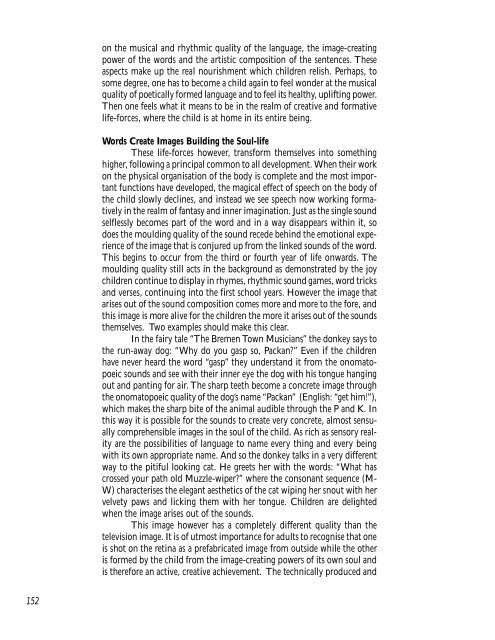Colloquium on English - Research Institute for Waldorf Education
Colloquium on English - Research Institute for Waldorf Education
Colloquium on English - Research Institute for Waldorf Education
Create successful ePaper yourself
Turn your PDF publications into a flip-book with our unique Google optimized e-Paper software.
152<br />
<strong>on</strong> the musical and rhythmic quality of the language, the image-creating<br />
power of the words and the artistic compositi<strong>on</strong> of the sentences. These<br />
aspects make up the real nourishment which children relish. Perhaps, to<br />
some degree, <strong>on</strong>e has to become a child again to feel w<strong>on</strong>der at the musical<br />
quality of poetically <strong>for</strong>med language and to feel its healthy, uplifting power.<br />
Then <strong>on</strong>e feels what it means to be in the realm of creative and <strong>for</strong>mative<br />
life-<strong>for</strong>ces, where the child is at home in its entire being.<br />
Words Create Images Building the Soul-life<br />
These life-<strong>for</strong>ces however, trans<strong>for</strong>m themselves into something<br />
higher, following a principal comm<strong>on</strong> to all development. When their work<br />
<strong>on</strong> the physical organisati<strong>on</strong> of the body is complete and the most important<br />
functi<strong>on</strong>s have developed, the magical effect of speech <strong>on</strong> the body of<br />
the child slowly declines, and instead we see speech now working <strong>for</strong>matively<br />
in the realm of fantasy and inner imaginati<strong>on</strong>. Just as the single sound<br />
selflessly becomes part of the word and in a way disappears within it, so<br />
does the moulding quality of the sound recede behind the emoti<strong>on</strong>al experience<br />
of the image that is c<strong>on</strong>jured up from the linked sounds of the word.<br />
This begins to occur from the third or fourth year of life <strong>on</strong>wards. The<br />
moulding quality still acts in the background as dem<strong>on</strong>strated by the joy<br />
children c<strong>on</strong>tinue to display in rhymes, rhythmic sound games, word tricks<br />
and verses, c<strong>on</strong>tinuing into the first school years. However the image that<br />
arises out of the sound compositi<strong>on</strong> comes more and more to the <strong>for</strong>e, and<br />
this image is more alive <strong>for</strong> the children the more it arises out of the sounds<br />
themselves. Two examples should make this clear.<br />
In the fairy tale “The Bremen Town Musicians” the d<strong>on</strong>key says to<br />
the run-away dog: “Why do you gasp so, Packan?” Even if the children<br />
have never heard the word “gasp” they understand it from the <strong>on</strong>omatopoeic<br />
sounds and see with their inner eye the dog with his t<strong>on</strong>gue hanging<br />
out and panting <strong>for</strong> air. The sharp teeth become a c<strong>on</strong>crete image through<br />
the <strong>on</strong>omatopoeic quality of the dog’s name “Packan” (<strong>English</strong>: “get him!”),<br />
which makes the sharp bite of the animal audible through the P and K. In<br />
this way it is possible <strong>for</strong> the sounds to create very c<strong>on</strong>crete, almost sensually<br />
comprehensible images in the soul of the child. As rich as sensory reality<br />
are the possibilities of language to name every thing and every being<br />
with its own appropriate name. And so the d<strong>on</strong>key talks in a very different<br />
way to the pitiful looking cat. He greets her with the words: “What has<br />
crossed your path old Muzzle-wiper?” where the c<strong>on</strong>s<strong>on</strong>ant sequence (M-<br />
W) characterises the elegant aesthetics of the cat wiping her snout with her<br />
velvety paws and licking them with her t<strong>on</strong>gue. Children are delighted<br />
when the image arises out of the sounds.<br />
This image however has a completely different quality than the<br />
televisi<strong>on</strong> image. It is of utmost importance <strong>for</strong> adults to recognise that <strong>on</strong>e<br />
is shot <strong>on</strong> the retina as a prefabricated image from outside while the other<br />
is <strong>for</strong>med by the child from the image-creating powers of its own soul and<br />
is there<strong>for</strong>e an active, creative achievement. The technically produced and

















